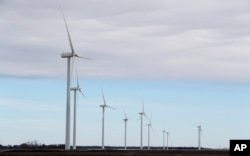Wind energy is a fast-growing power source in the United States.
Wind turbines, the huge devices that turn wind power into electricity, are being built across the country. Now several big companies are planning to invest $70 billion for the first large-scale wind farms in waters just off America’s coasts.
Polly McMahon’s family has been living on Block Island, a small island off the coast of Rhode Island for 13 generations. One of the first offshore wind farms replaced the island’s diesel-fueled power plant in 2016.
“We have been blessed to have it,” McMahon told the Associated Press.
However, the administration of President Donald Trump has not been as supportive of wind power.
Trump has made hundreds of comments on the website Twitter and in public opposing the expansion of wind power. “They say the noise causes cancer,” Trump told a crowd of supporters last spring. The AP reported that the American Cancer Society immediately rejected that claim.
Now, wind industry officials and activists are worried that the federal government may be pulling back from years of support for wind energy.
In August, the U.S. Interior Department announced it was withholding approval for the country’s first large-scale offshore wind project. The $2.8 billion project included 84 very large turbines.
The plan was to start building 24 kilometers from Martha’s Vineyard, an island off the coast of Massachusetts. Vineyard Wind hoped to start operating by 2022. The company has partners from the Netherlands and Spain. It already has agreements to supply electric utilities to Massachusetts.
Investors supporting several other big offshore wind projects of their own want to follow Vineyard Wind. The energy company Shell is among the businesses seeking agreements to pay for the use of federal land. Some are offering more than $100 million for offshore wind farm sites.
The Interior Department listed the growth in business interest for offshore wind projects as one reason it wanted more study before moving forward. It directed Vineyard Wind to research the overall effect of the East Coast’s wind industry growth.
Interior Department spokesman Nicholas Goodwin said in a statement that offshore energy remains an important part of the Trump administration’s energy plan. But that plan includes “ensuring activities are safe and environmentally responsible.”
Wind power now provides one third or more of the electricity created in some Southwestern and Midwestern states. New York, New Jersey and some other Eastern states already are exploring wind projects.
But the Interior Department’s move to delay the Vineyard Wind project raised concerns among industry supporters.
Critics note the decision to delay the Vineyard Wind project came as the administration moves to open up offshore and Arctic areas to oil and gas development. It does so despite strong environmental concerns.
Stephanie McClellan is a researcher and director of the Special Initiative on Offshore Wind at the University of Delaware. She said the decision is worrying because developers have never had to study the effect of all projects, only their own.
Thomas Brostrom is head of U.S. operations for Denmark’s international offshore wind company Orsted. Orsted operates the Block Island wind farm in Rhode Island. Brostrom said, “the last three, four years have seen unbelievable, explosive growth, much more than we could have really hoped for,” in the U.S. Europe’s already established wind power industry has not seen the same, he said.
Opposition to offshore wind power over the years
Public opinion of wind power has changed, since America’s first major, proposed offshore wind project, Cape Wind off the coast of Cape Cod, Massachusetts. Influential people living in the area pushed to halt the plan 16 years ago. They said the turbines would kill birds and ruin the appearance of the natural sea coast.
But new technological developments in recent years permit wind turbines to be placed further offshore. They also produce energy more efficiently. The issue of climate change also has many looking at wind differently now.
Federal fisheries officials are calling for more study. They say they need to know more about the effect of wind farms on ocean life. Some fishing groups are concerned their equipment will get caught in the structures.
As a result, Vineyard Wind has offered to pay millions of dollars for harm to fishing businesses.
On land, wind industry growth already is well established. The U.S. Energy Information Administration reports that, by next year, nine percent of the country’s electricity is expected to come from wind power. The wind industry says it supports 114,000 jobs. That is more than double the number of jobs in the U.S. coal industry.
I’m Dorothy Gundy.
And I’m Pete Musto.
Ellen Knickmeyer and Rodrique Ngowi reported this story for the Associated Press. Pete Musto adapted it for VOA Learning English. Mario Ritter Jr. was the editor. We want to hear from you. How popular is wind energy in your country? Write to us in the Comments Section.
________________________________________________________________
Words in This Story
source – n. someone or something that provides what is wanted or needed
large-scale – adj. involving many people or things
offshore – adj. located in the ocean away from the shore
blessed – adj. lucky, pleased or fortunate
utilities – n. services, such as a supply of electricity or water, that are provided to the public
efficiently – adv. done in a way that able to produce desired results without wasting materials, time, or energy
fisheries – n. parts of the ocean where fish and other sea creatures are caught








